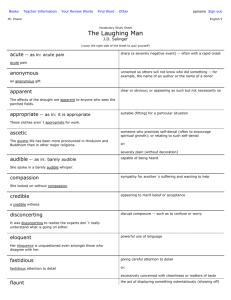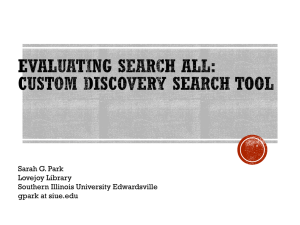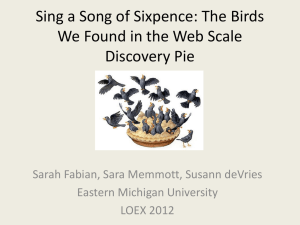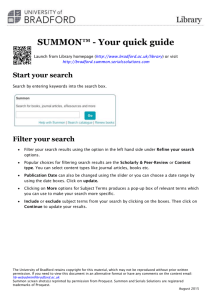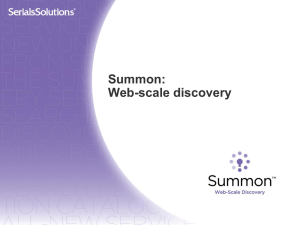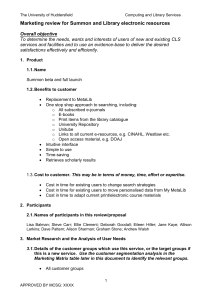- University of Huddersfield Repository
advertisement
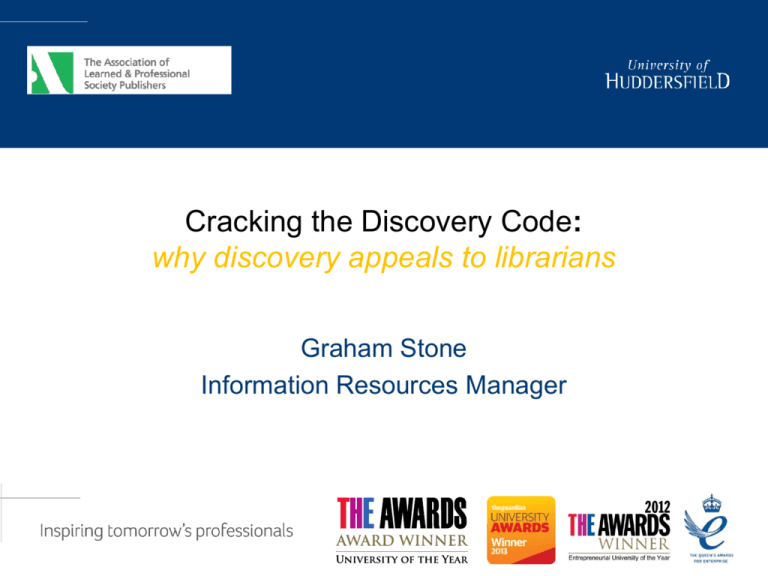
Cracking the Discovery Code: why discovery appeals to librarians Graham Stone Information Resources Manager Some context • Webscale discovery systems – Pre-harvested content with a single search interface – On the market for approximately 5 years – Summon, Worldcat local, Primo Central, Ebsco Discovery Service • Federated search and link resolvers – Out of scope for this session – Although still important! – …and don’t forget KBART (more on that later) UK’s 1st Summon customer 2009 3 E-resources @ Huddersfield “Why is Google so easy and the library so hard?” [Tenopir, 2009] http://www.flickr.com/photos/ppl_ri_images/4019188259/ “Why do we want to teach our users to be librarians?” [Pattern, 2009] http://www.flickr.com/photos/manfrys/2226178289/ What do we know about webscale discovery? • Web Scale Discovery Services increase accessibility of e-resources and will definitely on the whole increase fulltext downloads • Undergraduates generally love discovery services • Librarians reactions towards discovery services are mixed at best Aaron Tay, Senior Librarian at National University of Singapore 8 things we know about web scale discovery systems in 2013 http://tinyurl.com/naflluz The usage element • Libraries are under increasing pressure to show value for money • Work on the Library Impact Data Project has shown a link between eresource usage and attainment/retention COUNTER downloads Big deal 1 COUNTER downloads Big deal 2 COUNTER downloads Big deal 3 COUNTER downloads Society publisher COUNTER downloads Publisher not indexed in Summon COUNTER downloads Full text aggregator – in Summon! COUNTER downloads Full text aggregator – not in Summon! COUNTER downloads A&I database The bigger picture It’s not just a Huddersfield thing • Grand Valley and Manitoba saw a dramatic increase in FT downloads for e-journals and a drop in A&I after Summon implementation • UTSA saw FT downloads increase by 23% after Summon implementation • ODU saw increases after implementation of WorldCat Local – “…lowest amount of usage in a single month for the year of 2011 was higher than the highest usage month in 2010” The user’s view Enhancing the student experience https://flic.kr/p/ohRcCA Abdul PHD student and part-time lecturer Summon is bloody brilliant… …It gives fast, efficient and above all relevant search results 17 Nicole Undergraduate student You’ve not got as many fiddly bits to do; you just type in what you want. It’s almost like Google Scholar, so I like it for that. 18 Senior Lecturer University of Huddersfield I love Summon, even an idiot like me can use it 19 The librarian’s view Culture shock? https://flic.kr/p/btbrEW Dave Pattern University of Huddersfield If your idea of a “good time” is to scare undergraduates in training sessions by showing them journal database interfaces — “it’s OK, I’m a friendly librarian and I’m here to show you just how hard it can be to find an article!” — then it’s probably high time you sought medical counselling ;-)” Pete Coco Grand Valley State University via ILI-L List What Summon frees me to do... ...particularly in freshman courses, is to focus more on the concepts of information literacy that this system so elegantly demonstrates. What is peer-review? Why does it matter? What is the difference between Google and the library? How does Google decide what to show you? Summon? Why isn't the stuff in Summon in Google?” Dr Antony Osborne Academic Librarian, University of Huddersfield The greatest impact on the way we teach information literacy is that it feels much simpler than having to go through lots of different databases with students Cancellation and acquisition A deal breaker? • TERMS top 14 deal breakers when licensing electronic resources • #10 Ability to use the resource and resource records with third party discovery tools https://library3.hud.ac.uk/blogs/terms/terms/acquiring-new-content/ References • • • • • • Graves, T., & Dresselhaus, A. (2012). One academic library, One year of web-scale discovery. The Serials Librarian, 62(1-4), 169-175. doi: 10.1080/0361526X.2012.652915 Kemp, J. (2012). Does web-scale discovery make a difference? Changes in collections use after implementing Summon. In M. P. Popp & D. Dallis (Eds.). Planning and implementing resource discovery tools in academic libraries (pp. 456-468). Hershey, PA: IGI Global. O'Hara, L. (2012) Collection Usage Pre- and Post-Summon Implementation at the University of Manitoba Libraries. Evidence Based Library and Information Practice, 7(4), 25-34. http://ejournals.library.ualberta.ca/index.php/EBLIP/article/view/12166 Thoburn, J., Coates, A., & Stone, G. (2012) Simplifying resource discovery and access in academic libraries: Implementing and evaluating Summon at Huddersfield and Northumbria Universities. In M. P. Popp & D. Dallis (Eds.). Planning and implementing resource discovery tools in academic libraries (pp. 580-597). Hershey, PA: IGI Global. http://eprints.hud.ac.uk/12138/ Way, D. (2010). The impact of web-scale discovery on the use of a library collection. Serials Review, 36(4) 214-220. doi: 10.1016/j.serrev.2010.07.002 Emery, Jill and Stone, Graham (2013) TERMS: Techniques for electronic resources management. Library Technology Reports, 49(2). pp. 5-43 Thank you! Graham Stone g.stone@hud.ac.uk @Graham_Stone #6terms http://eprints.hud.ac.uk/21270 This work is licensed under a Creative Commons Attribution 3.0 Unported License
